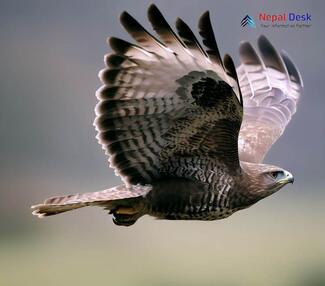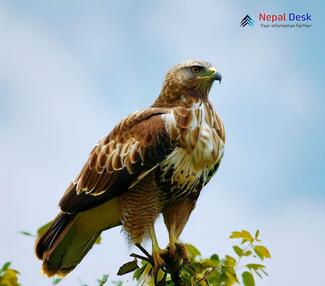In the diverse and captivating world of birds, the Upland Buzzard (Buteo hemilasius) holds a unique position, earning admiration from birdwatchers and ornithologists alike. Found primarily in Asia, this magnificent bird of prey can also be sighted in countries like Nepal, where its beauty and grace never fail to leave an impression. In this article, let's delve deep into the fascinating world of the Upland Buzzard, uncovering information about its habitat, behavior, and why it's essential to conserve its presence in Nepal.
A Bird Unlike Any Other: The Upland Buzzard
The Upland Buzzard is a large raptor belonging to the Buteo genus, which boasts a wingspan of up to 150 cm. What sets this buzzard species apart from others is its striking physical appearance: predominantly pale white with contrasting dark markings on its flight feathers and tail. Its eyes are bright yellow, almost golden in color, adding to its majestic aura.
Although not heavily sexually dimorphic, female Upland Buzzards tend to be slightly larger than males. They generally weigh around 1.6 kg while males weigh about 1.3 kg.
Habitat Insights: Where Does the Upland Buzzard Call Home?
As its name suggests, the Upland Buzzard can usually be found in high-altitude grasslands and hillsides of Asia. Their geographical range stretches across countries like Mongolia, China, India, Bhutan, and of course, Nepal.
In Nepal specifically, they are often sighted at elevations between 2,500 and 4,500 meters above sea level. You have a higher chance of spotting these captivating raptors during winter when they migrate to areas with milder climates.
Behavioral Traits: Into the Life of an Upland Buzzard
Upland Buzzards lead a solitary lifestyle outside of their nesting period. They are known for their strong territorial instincts, and males may engage in close-range "sky-dancing" displays to establish dominance over a territory.
These birds are daytime hunters, relying on their keen eyesight to spot potential prey from high up in the sky. They primarily feed on rodents such as voles, pikas, and occasionally birds and carrion.
Upland Buzzards typically lay 2-4 eggs, with both parents helping in the incubation and feeding of the chicks. The young ones fledge after around 45 days and become independent within the next two months.
The Need for Conservation
As with many species worldwide, habitat destruction, human encroachment, and climate change pose significant threats to the Upland Buzzard population. In Nepal, these buzzards are spotted more sporadically in recent years, drawing concern from conservationists.
To protect this fascinating species and preserve its presence in Nepal, it's essential to implement conservation programs that focus on habitat restoration and creating protected areas. Additionally, educating local communities about the importance of these raptors in maintaining a healthy ecosystem can go a long way toward ensuring their survival.
In conclusion, the Upland Buzzard is an awe-inspiring bird of prey that graces the skies of Asia, including Nepal. By learning more about this magnificent creature and taking active steps to conserve its habitat, we contribute to safeguarding a part of our planet's rich biodiversity. So next time you spot an Upland Buzzard soaring above while visiting Nepal or elsewhere in Asia, take a moment to appreciate its beauty and remember that every creature plays a vital role in our rich tapestry of life.




